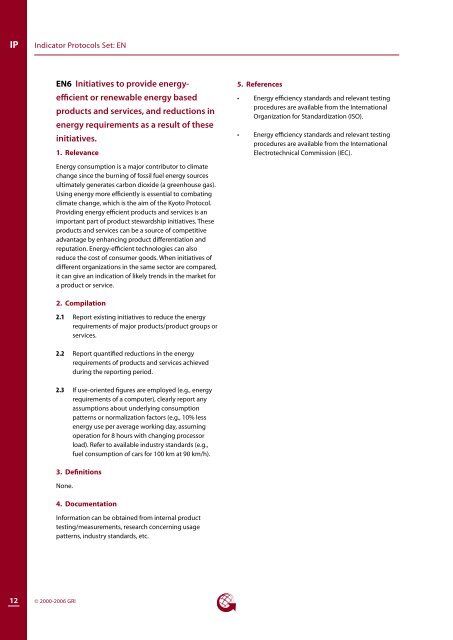Environment - Global Reporting Initiative
Environment - Global Reporting Initiative
Environment - Global Reporting Initiative
You also want an ePaper? Increase the reach of your titles
YUMPU automatically turns print PDFs into web optimized ePapers that Google loves.
IP<br />
Indicator Protocols Set: EN<br />
EN6 <strong>Initiative</strong>s to provide energyefficient<br />
or renewable energy based<br />
products and services, and reductions in<br />
energy requirements as a result of these<br />
initiatives.<br />
1. Relevance<br />
5. References<br />
• Energy efficiency standards and relevant testing<br />
procedures are available from the International<br />
Organization for Standardization (ISO).<br />
• Energy efficiency standards and relevant testing<br />
procedures are available from the International<br />
Electrotechnical Commission (IEC).<br />
Energy consumption is a major contributor to climate<br />
change since the burning of fossil fuel energy sources<br />
ultimately generates carbon dioxide (a greenhouse gas).<br />
Using energy more efficiently is essential to combating<br />
climate change, which is the aim of the Kyoto Protocol.<br />
Providing energy efficient products and services is an<br />
important part of product stewardship initiatives. These<br />
products and services can be a source of competitive<br />
advantage by enhancing product differentiation and<br />
reputation. Energy-efficient technologies can also<br />
reduce the cost of consumer goods. When initiatives of<br />
different organizations in the same sector are compared,<br />
it can give an indication of likely trends in the market for<br />
a product or service.<br />
2. Compilation<br />
2.1 Report existing initiatives to reduce the energy<br />
requirements of major products/product groups or<br />
services.<br />
2.2 Report quantified reductions in the energy<br />
requirements of products and services achieved<br />
during the reporting period.<br />
2.3 If use-oriented figures are employed (e.g., energy<br />
requirements of a computer), clearly report any<br />
assumptions about underlying consumption<br />
patterns or normalization factors (e.g., 10% less<br />
energy use per average working day, assuming<br />
operation for 8 hours with changing processor<br />
load). Refer to available industry standards (e.g.,<br />
fuel consumption of cars for 100 km at 90 km/h).<br />
3. Definitions<br />
None.<br />
4. Documentation<br />
Information can be obtained from internal product<br />
testing/measurements, research concerning usage<br />
patterns, industry standards, etc.<br />
12<br />
© 2000-2006 GRI

















